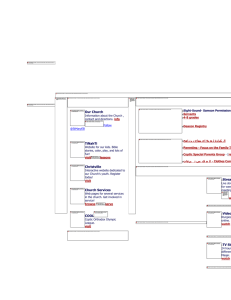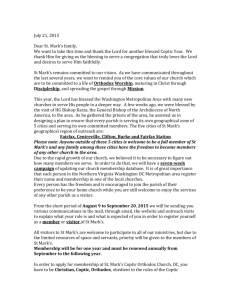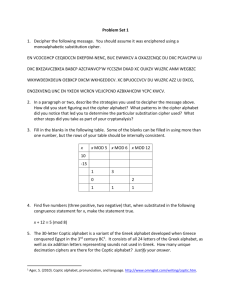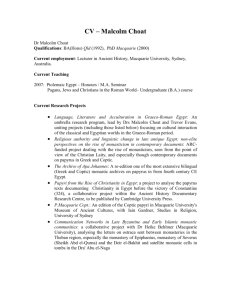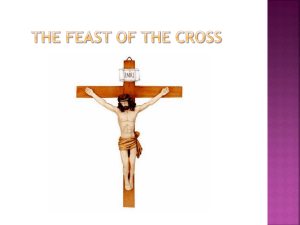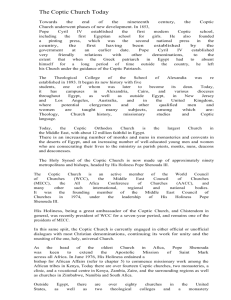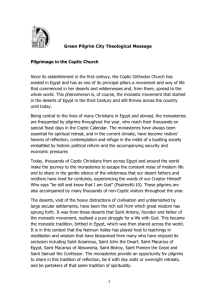L2/11-062
advertisement
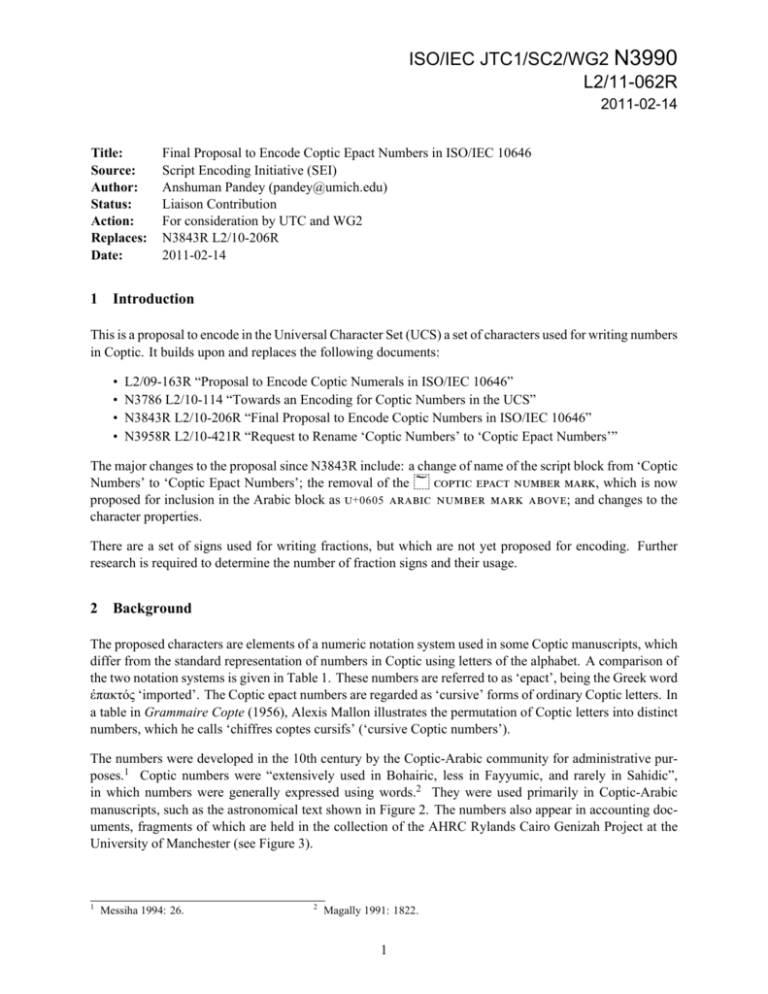
ISO/IEC JTC1/SC2/WG2 N3990 L2/11-062R 2011-02-14 Title: Source: Author: Status: Action: Replaces: Date: 1 Final Proposal to Encode Coptic Epact Numbers in ISO/IEC 10646 Script Encoding Initiative (SEI) Anshuman Pandey (pandey@umich.edu) Liaison Contribution For consideration by UTC and WG2 N3843R L2/10-206R 2011-02-14 Introduction This is a proposal to encode in the Universal Character Set (UCS) a set of characters used for writing numbers in Coptic. It builds upon and replaces the following documents: • • • • L2/09-163R “Proposal to Encode Coptic Numerals in ISO/IEC 10646” N3786 L2/10-114 “Towards an Encoding for Coptic Numbers in the UCS” N3843R L2/10-206R “Final Proposal to Encode Coptic Numbers in ISO/IEC 10646” N3958R L2/10-421R “Request to Rename ‘Coptic Numbers’ to ‘Coptic Epact Numbers’” The major changes to the proposal since N3843R include: a change of name of the script block from ‘Coptic Numbers’ to ‘Coptic Epact Numbers’; the removal of the , which is now proposed for inclusion in the Arabic block as + 0605 ; and changes to the character properties. There are a set of signs used for writing fractions, but which are not yet proposed for encoding. Further research is required to determine the number of fraction signs and their usage. 2 Background The proposed characters are elements of a numeric notation system used in some Coptic manuscripts, which differ from the standard representation of numbers in Coptic using letters of the alphabet. A comparison of the two notation systems is given in Table 1. These numbers are referred to as ‘epact’, being the Greek word ἐπακτός ‘imported’. The Coptic epact numbers are regarded as ‘cursive’ forms of ordinary Coptic letters. In a table in Grammaire Copte (1956), Alexis Mallon illustrates the permutation of Coptic letters into distinct numbers, which he calls ‘chiffres coptes cursifs’ (‘cursive Coptic numbers’). The numbers were developed in the 10th century by the Coptic-Arabic community for administrative purposes.1 Coptic numbers were “extensively used in Bohairic, less in Fayyumic, and rarely in Sahidic”, in which numbers were generally expressed using words.2 They were used primarily in Coptic-Arabic manuscripts, such as the astronomical text shown in Figure 2. The numbers also appear in accounting documents, fragments of which are held in the collection of the AHRC Rylands Cairo Genizah Project at the University of Manchester (see Figure 3). 1 Messiha 1994: 26. 2 Magally 1991: 1822. 1 Final Proposal to Encode Coptic Epact Numbers in ISO/IEC 10646 Anshuman Pandey The Coptic numbers appear in specimens included by Michael Everson in a document from 2003 titled “Revised proposal to add the Coptic alphabet to the BMP of the UCS” (N2636); ie. in Figure 14, of which an excerpt is given here in Figure 7. Everson did not propose the encoding of the Coptic numbers, but stated that “further study may indicate that some of the additional characters and symbols shown here should also be added to the Standard”. Indeed, additional research has shown that the ‘Signes de numération’ illustrated in the figure are described in several sources, such as by Antoine P. Pihan in Exposé des signes de numération (1860). The present proposal aims to contribute to Everson’s work on encoding Coptic in the UCS by further developing support for the script. Considering that the Coptic Numbers are variations on the standard cursive forms of Coptic letters, it may be possible to unify them with existing Coptic letters. However, these numbers were generally used in specialized contexts, such as Coptic-Arabic manuscripts, in which the regular manner of writing numbers using letters of the alphabet was not practiced. Moreover, the depiction of these characters as unique elements of the Coptic script, as shown in Figure 5 and Figure 7, further indicates that these characters were considered sufficiently distinct from the original alphabetic sources to warrant representation using independent glyphs in sets of metal fonts. These factors strongly recommend the independent encoding for Coptic Numbers. An encoding for the Coptic Numbers will enhance the Coptic repertoire in the UCS by offering a means for representing characters used in the broader corpus of Coptic records. 3 Proposal Details The characters are proposed for encoding in a new script block to be named ‘Coptic Epact Numbers’. The block is allocated to the SMP at the range U+102E0..U+102FF. The proposed code chart and names list are shown in Figure 1. 3.1 Name of Script Block Earlier proposals used the name ‘Coptic Numbers’ for the script block. This name is too generic. It implies that the proposed characters are regular Coptic numbers. In N3886, Michael Everson and Stephen Emmel use the term ‘epact’ when referring to the proposed characters; ‘epact’ being the Greek word ἐπακτός ‘imported’. It was determined that the name of the proposed script block be modified to incorporate this adjective. The resulting name ‘Coptic Epact Numerals’ more accurately describes the characters, and facilitates identification and appropriate usage of the characters. 3.2 Character Names The names of the characters follow UCS naming conventions. Character names for the digits 1–9 possess the descriptor ‘’ and all other numbers are called ‘’. 4 4.1 The Notation System Structure Coptic Epact Numbers represent units of a positional decimal system. It is an additive system; the value of a numeric sequence is the sum of each number that constitutes it. There is no character for zero; it is inherently represented in the distinct numbers of each decimal order. There are numbers for the primary, tens, and hundreds orders; the thousands are represented by means of a sublinear diacritic. Numbers are written left-to-right. 2 Final Proposal to Encode Coptic Epact Numbers in ISO/IEC 10646 4.2 Anshuman Pandey Orthography Basic Notation The thousands are represented by writing a primary number and ◌𐋠 : 𐋥 + ◌𐋠 = 𐋥𐋠 5,000. The ten thousands are written using a tens number and the : 𐋮 + ◌𐋠 = 𐋮𐋠 50,000. The hundred thousands are written with a number for the hundreds and the : 𐋷 + ◌𐋠 = 𐋷𐋠 500,000. Large Numbers In theory, decimal orders larger than hundred thousand may be represented by writing the twice, eg. 𐋡𐋠 = 1,000; 𐋡𐋠𐋠 = 1,000,000. This practice mirrors the convention in Coptic of indicating higher decimal orders by duplicating diacritics, eg. overline ◌̅ + 0305 is doubled as ◌̿ + 033F to indicate the thousands, eg. ⲁ̅ = 1; = 1,000. Composite Numbers Composite numbers are produced by writing a primary number and a number from a larger decimal order. The larger number is written first, then the primary number: 𐋫𐋥 = 25 ( + ); 𐋴𐋥 = 205 ( + ); 𐋴𐋮 = 250 ( + ). Fractions Fraction numbers are written using a set of unique signs (see Figure 10). Further research is required to determine the notation system for fractions. Number Mark Numbers in Coptic are often marked using a supralinear diacritic such as an ◌̅ overline, eg. ⲛ̅ = 50. As shown in Figure 4, the overline is also used with Coptic Epact Numbers. Some sources, such as that shown in Figure 6, show the use of a distinctive serpentine diacritic ◌ for marking numbers. Similar to the overline, this supralinear mark extends over the entire width of a single digit or a sequence of numbers: 𐋥 = 5; 𐋪𐋥 = 15; 𐋷𐋮 = 550; 𐋥𐋠𐋷𐋥 = 5,505. As this serpentine mark occurs in Coptic and Arabic contexts, it has been proposed for encoding in the Arabic block as + 0605 . 4.3 Variant Forms Variant forms of Coptic Epact Numbers are attested, eg. the shapes of , , , etc. in Figure 4. These variant forms may be unified with the corresponding characters proposed here. 5 Implementation Details 5.1 Character Properties 102E0 102E1 102E2 102E3 102E4 102E5 102E6 102E7 102E8 102E9 102EA 102EB 102EC 102ED 102EE 102EF COPTIC COPTIC COPTIC COPTIC COPTIC COPTIC COPTIC COPTIC COPTIC COPTIC COPTIC COPTIC COPTIC COPTIC COPTIC COPTIC EPACT EPACT EPACT EPACT EPACT EPACT EPACT EPACT EPACT EPACT EPACT EPACT EPACT EPACT EPACT EPACT THOUSANDS MARK;Mn;0;EN;;;;1000;N;;;;; DIGIT ONE;No;0;EN;;;;1;N;;;;; DIGIT TWO;No;0;EN;;;;2;N;;;;; DIGIT THREE;No;0;EN;;;;3;N;;;;; DIGIT FOUR;No;0;EN;;;;4;N;;;;; DIGIT FIVE;No;0;EN;;;;5;N;;;;; DIGIT SIX;No;0;EN;;;;6;N;;;;;; DIGIT SEVEN;No;0;EN;;;;7;N;;;;; DIGIT EIGHT;No;0;EN;;;;8;N;;;;; DIGIT NINE;No;0;EN;;;;9;N;;;;; NUMBER TEN;No;0;EN;;;;10;N;;;;; NUMBER TWENTY;No;0;EN;;;;20;N;;;;; NUMBER THIRTY;No;0;EN;;;;30;N;;;;; NUMBER FORTY;No;0;EN;;;;40;N;;;;; NUMBER FIFTY;No;0;EN;;;;50;N;;;;; NUMBER SIXTY;No;0;EN;;;;60;N;;;;; 3 Final Proposal to Encode Coptic Epact Numbers in ISO/IEC 10646 102F0 102F1 102F2 102F3 102F4 102F5 102F6 102F7 102F8 102F9 102FA 102FB 5.2 COPTIC COPTIC COPTIC COPTIC COPTIC COPTIC COPTIC COPTIC COPTIC COPTIC COPTIC COPTIC EPACT EPACT EPACT EPACT EPACT EPACT EPACT EPACT EPACT EPACT EPACT EPACT NUMBER NUMBER NUMBER NUMBER NUMBER NUMBER NUMBER NUMBER NUMBER NUMBER NUMBER NUMBER Anshuman Pandey SEVENTY;No;0;EN;;;;70;N;;;;; EIGHTY;No;0;EN;;;;80;N;;;;; NINETY;No;0;EN;;;;90;N;;;;; ONE HUNDRED;No;0;EN;;;;100;N;;;;; TWO HUNDRED;No;0;EN;;;;200;N;;;;; THREE HUNDRED;No;0;EN;;;;300;N;;;;; FOUR HUNDRED;No;0;EN;;;;400;N;;;;; FIVE HUNDRED;No;0;EN;;;;500;N;;;;; SIX HUNDRED;No;0;EN;;;;600;N;;;;; SEVEN HUNDRED;No;0;EN;;;;700;N;;;;;; EIGHT HUNDRED;No;0;EN;;;;800;N;;;;; NINE HUNDRED;No;0;EN;;;;900;N;;;;; ‘Confusable’ Characters Below is a list of Coptic Epact Numbers that are ‘confusable’ with other characters: 102E1 COPTIC EPACT DIGIT ONE ; 062F ARABIC LETTER DAL 102E9 COPTIC EPACT DIGIT NINE ; 03B8 GREEK SMALL LETTER THETA 102F3 COPTIC EPACT NUMBER ONE HUNDRED ; 06D2 ARABIC LETTER YEH BARREE 6 References AHRC Rylands Cairo Genizah Project. “Coptic numerals?” http://enriqueta.man.ac.uk:8180/luna/ servlet/view/all/what/Coptic+numerals%3F. Accessed June 2010. Everson, Michael. 2003. “Revised proposal to add the Coptic alphabet to the BMP of the UCS” (ISO/IEC JTC1/SC2/WG2 N2636). http://std.dkuug.dk/jtc1/sc2/wg2/docs/n2636.pdf Everson, Michael and Stephen Emmel. 2010. “Towards the encoding of a complete set of Coptic numbers in the UCS” (ISO/IEC JTC1/SC2/WG2 N3886 L2/10-333). http://std.dkuug.dk/jtc1/sc2/wg2/ docs/n3886.pdf Geiss, M. Albert. 1906. De l’établissement des manuscrits destinés a l’impression. Caire: Imprimerie de l’institut français d’archéologie orientale. King, David A. 2001. The Ciphers of the Monks: A Forgotten Number-Notation of the Middle Ages. Stuttgart: F. Steiner. Mallon, Alexis. 1956. Grammaire Copte. Bibliographie, chrestomathie et vocabulaire. Beyrouth: Imprimerie catholique. Megally, Fuad. 1991. “Numerical System, Coptic”. Coptic Encyclopedia, ed. by Aziz S. Atiya, pp. 1820–1822. New York: Macmillan Publishing Co. Messiha, Heshmat. 1994. “Les chiffres coptes”. Le monde copte, vol. 24, pp. 25–28. Pandey, Anshuman. 2009. “Proposal to Encode Coptic Numerals in ISO/IEC 10646” (L2/09-163R). http: //www-personal.umich.edu/~pandey/09163-copticnumerals.pdf ———. 2010a. “Towards an Encoding for Coptic Numbers in the UCS” (ISO/IEC JTC1/SC2/WG2 N3786 L2/10-114). http://std.dkuug.dk/jtc1/sc2/wg2/docs/n3786.pdf 4 Final Proposal to Encode Coptic Epact Numbers in ISO/IEC 10646 Anshuman Pandey ———. 2010b. “Final Proposal to Encode Coptic Numbers in ISO/IEC 10646” (ISO/IEC JTC1/SC2/WG2 N3843R L2/10-206R). http://std.dkuug.dk/jtc1/sc2/wg2/docs/n3843.pdf ———. 2010c. “Request to Rename ‘Coptic Numbers’ to ‘Coptic Epact Numbers”’ (ISO/IEC JTC1/SC2/WG2 N3958R L2/10-421R). http://std.dkuug.dk/jtc1/sc2/wg2/docs/n3958.pdf Pihan, Antoine Paulin. 1860. Exposé des signes de numération usités chez les peuples orientaux anciens et modernes. Paris: L’imprimerie impériale. Stern, Ludwig. 1880. Koptische Grammatik. Leipzig: T. O. Weigel. 7 Acknowledgments I would like to thank Traianos Gagos and Terry Wilfong, both of the University of Michigan, for sharing their comments on L2/09-163R. I would also like to express thanks to Michael Everson and Stephen Emmel for providing valuable feedback on earlier documents. This project was made possible in part by a grant from the United States National Endowment for the Humanities, which funded the Universal Scripts Project (part of the Script Encoding Initiative at the University of California, Berkeley). Any views, findings, conclusions or recommendations expressed in this publication do not necessarily reflect those of the National Endowment of the Humanities. 5 Coptic Epact Numbers Final Proposal to Encode Coptic Epact Numbers 102E0in ISO/IEC 10646 g UniBook™ unicode.org/unibook/) 102E 102F 0 1 2 $𐋠 𐋰 102E0 102F0 𐋡 𐋱 102E1 102F1 𐋢 𐋲 102E2 3 4 5 6 7 8 9 A B C 102F2 𐋣 𐋳 102E3 102F3 𐋤 𐋴 102E4 102F4 𐋥 𐋵 102E5 102F5 𐋦 𐋶 102E6 102F6 𐋧 𐋷 102E7 102F7 𐋨 𐋸 102E8 102F8 𐋩 𐋹 102E9 102F9 𐋪 𐋺 102EA 102FA 𐋫 𐋻 102EB 102FB 102FF Anshuman Pandey Coptic Epact Numbers Sign 102E0 $𐋠 COPTIC EPACT THOUSANDS MARK Digits 102E1 102E2 102E3 102E4 102E5 102E6 102E7 102E8 102E9 𐋡 𐋢 𐋣 𐋤 𐋥 𐋦 𐋧 𐋨 𐋩 COPTIC EPACT DIGIT ONE COPTIC EPACT DIGIT TWO COPTIC EPACT DIGIT THREE COPTIC EPACT DIGIT FOUR COPTIC EPACT DIGIT FIVE COPTIC EPACT DIGIT SIX COPTIC EPACT DIGIT SEVEN COPTIC EPACT DIGIT EIGHT COPTIC EPACT DIGIT NINE Numbers 102EA 102EB 102EC 102ED 102EE 102EF 102F0 102F1 102F2 102F3 102F4 102F5 102F6 102F7 102F8 102F9 102FA 102FB 𐋪 𐋫 𐋬 𐋭 𐋮 𐋯 𐋰 𐋱 𐋲 𐋳 𐋴 𐋵 𐋶 𐋷 𐋸 𐋹 𐋺 𐋻 COPTIC EPACT NUMBER TEN COPTIC EPACT NUMBER TWENTY COPTIC EPACT NUMBER THIRTY COPTIC EPACT NUMBER FORTY COPTIC EPACT NUMBER FIFTY COPTIC EPACT NUMBER SIXTY COPTIC EPACT NUMBER SEVENTY COPTIC EPACT NUMBER EIGHTY COPTIC EPACT NUMBER NINETY COPTIC EPACT NUMBER ONE HUNDRED COPTIC EPACT NUMBER TWO HUNDRED COPTIC EPACT NUMBER THREE HUNDRED COPTIC EPACT NUMBER FOUR HUNDRED COPTIC EPACT NUMBER FIVE HUNDRED COPTIC EPACT NUMBER SIX HUNDRED COPTIC EPACT NUMBER SEVEN HUNDRED COPTIC EPACT NUMBER EIGHT HUNDRED COPTIC EPACT NUMBER NINE HUNDRED 𐋬 102EC D 𐋭 102ED E 𐋮 102EE F 𐋯 102EF Figure 1: Proposed code chart and nameslist for Coptic Epact Numbers Date: 14-Feb-2011 6 Printed using UniBook™ (http://www.unicode.org/unibook/) 1 Date: 14-Feb-2011 Final Proposal to Encode Coptic Epact Numbers in ISO/IEC 10646 1 10 100 Anshuman Pandey 1 2 3 4 5 6 7 8 9 𐋡 𐋢 𐋣 𐋤 𐋥 𐋦 𐋧 𐋨 𐋩 ⲁ̅ ⲃ̅ ⲅ̅ ⲇ̅ ⲉ̅ ⲋ̅ ⲍ̅ ⲏ̅ ⲑ̅ 𐋪 𐋫 𐋬 𐋭 𐋮 𐋯 𐋰 𐋱 𐋲 ⲓ̅ ⲕ̅ ⲗ̅ ⲙ̅ ⲛ̅ ⲝ̅ ⲟ̅ ⲡ̅ ϥ̅ 𐋳 𐋴 𐋵 𐋶 𐋷 𐋸 𐋹 𐋺 𐋻 ⲣ̅ ⲥ̅ ⲧ̅ ⲩ̅ ⲫ̅ ⲭ̅ ⲯ̅ ⲱ̅ ⳨ 𐋡𐋠 𐋢𐋠 𐋣𐋠 𐋤𐋠 𐋥𐋠 𐋦𐋠 𐋧𐋠 𐋨𐋠 𐋩𐋠 𐋪𐋠 𐋫𐋠 𐋬𐋠 𐋭𐋠 𐋮𐋠 𐋯𐋠 𐋰𐋠 𐋱𐋠 𐋲𐋠 𐋳𐋠 𐋴𐋠 𐋵𐋠 𐋶𐋠 𐋷𐋠 𐋸𐋠 𐋹𐋠 𐋺𐋠 𐋻𐋠 1,000 10,000 100,000 ⳨̿ Table 1: Numbers written using Coptic epact numbers (top) and the alphabetic system (bottom). 7 Final Proposal to Encode Coptic Epact Numbers in ISO/IEC 10646 Anshuman Pandey Figure 2: Excerpt of an astronomical table showing the use of Coptic epact numbers with the Arabic script (from King 2001: Appendix C, p. 299). 8 Final Proposal to Encode Coptic Epact Numbers in ISO/IEC 10646 Anshuman Pandey Figure 3: Coptic epact numbers in a manuscript fragment from the Rylands Genizah collection (AHRC Rylands Cairo Genizah Project fragment B 6548-1). 9 Final Proposal to Encode Coptic Epact Numbers in ISO/IEC 10646 Anshuman Pandey Figure 4: Comparison of Coptic letters and ‘cursive letters’ (from Megally 1991: 1821). The ‘cursive letters’ represent Coptic epact numbers. Note the use of the overline as a number mark in both notation systems. Also note the use of ◌𐋠 in the regular alphabetic system. 10 Final Proposal to Encode Coptic Epact Numbers in ISO/IEC 10646 Anshuman Pandey Figure 5: Table showing the forms of Coptic epact numbers (from Pihan 1860: 213). Figure 6: Table showing composite numbers (from Pihan 1860: 214). Note the use of the serpentine ‘number mark’. 11 Final Proposal to Encode Coptic Epact Numbers in ISO/IEC 10646 Anshuman Pandey Figure 7: Coptic epact numbers for the primary, tens, hundreds, and thousands shown in a specimen of Coptic type under the heading ‘Signes de numération’. Two length variants of the serpentine ‘number mark’ are shown under the heading ‘Lettres accentuées...’ (from Geiss 1906; reproduced in Everson 2003: Figure 14). Figure 8: The representation of numbers in Coptic using letters of the alphabet and horizontal overlines (reproduced from Everson 2003: Figure 12). 12 Final Proposal to Encode Coptic Epact Numbers in ISO/IEC 10646 Anshuman Pandey Figure 9: Table showing the Coptic epact numbers (from Mallon 1956: 234). 13 Final Proposal to Encode Coptic Epact Numbers in ISO/IEC 10646 Anshuman Pandey Figure 10: Coptic regular and epact numbers, including fractions ‘Brüche’ (from Stern 1880: 499). 14 ISO/IEC JTC 1/SC 2/WG 2 PROPOSAL SUMMARY FORM TO ACCOMPANY SUBMISSIONS 1 FOR ADDITIONS TO THE REPERTOIRE OF ISO/IEC 10646 Please fill all the sections A, B and C below. Please read Principles and Procedures Document (P & P) from http://www.dkuug.dk/JTC1/SC2/WG2/docs/principles.html for guidelines and details before filling this form. Please ensure you are using the latest Form from http://www.dkuug.dk/JTC1/SC2/WG2/docs/summaryform.html. See also http://www.dkuug.dk/JTC1/SC2/WG2/docs/roadmaps.html for latest Roadmaps. A. Administrative 1. Title: Final Proposal to Encode Coptic Epact Numbers in ISO/IEC 10646 2. Requester's name: Script Encoding Initiative / Anshuman Pandey <pandey@umich.edu> 3. Requester type (Member body/Liaison/Individual contribution): Liaison contribution 4. Submission date: 2011-02-14 5. Requester's reference (if applicable): 6. Choose one of the following: This is a complete proposal: Yes (or) More information will be provided later: B. Technical – General 1. Choose one of the following: a. This proposal is for a new script (set of characters): Yes Proposed name of script: Coptic Epact Numbers b. The proposal is for addition of character(s) to an existing block: Name of the existing block: 2. Number of characters in proposal: 28 3. Proposed category (select one from below - see section 2.2 of P&P document): A-Contemporary B.1-Specialized (small collection) X B.2-Specialized (large collection) C-Major extinct D-Attested extinct E-Minor extinct F-Archaic Hieroglyphic or Ideographic G-Obscure or questionable usage symbols 4. Is a repertoire including character names provided? Yes a. If YES, are the names in accordance with the “character naming guidelines” in Annex L of P&P document? Yes b. Are the character shapes attached in a legible form suitable for review? Yes 5. Fonts related: a. Who will provide the appropriate computerized font to the Project Editor of 10646 for publishing the standard? Anshuman Pandey b. Identify the party granting a license for use of the font by the editors (include address, e-mail, ftp-site, etc.): Anshuman Pandey <pandey@umich.edu> 6. References: a. Are references (to other character sets, dictionaries, descriptive texts etc.) provided? Yes b. Are published examples of use (such as samples from newspapers, magazines, or other sources) of proposed characters attached? Yes 7. Special encoding issues: Does the proposal address other aspects of character data processing (if applicable) such as input, presentation, sorting, searching, indexing, transliteration etc. (if yes please enclose information)? Yes, 8. Additional Information: Submitters are invited to provide any additional information about Properties of the proposed Character(s) or Script that will assist in correct understanding of and correct linguistic processing of the proposed character(s) or script. Examples of such properties are: Casing information, Numeric information, Currency information, Display behaviour information such as line breaks, widths etc., Combining behaviour, Spacing behaviour, Directional behaviour, Default Collation behaviour, relevance in Mark Up contexts, Compatibility equivalence and other Unicode normalization related information. See the Unicode standard at http://www.unicode.org for such information on other scripts. Also see http://www.unicode.org/Public/UNIDATA/UCD.html and associated Unicode Technical Reports for information needed for consideration by the Unicode Technical Committee for inclusion in the Unicode Standard. 1 Form number: N3702-F (Original 1994-10-14; Revised 1995-01, 1995-04, 1996-04, 1996-08, 1999-03, 2001-05, 2001-09, 2003-11, 2005-01, 2005-09, 2005-10, 2007-03, 2008-05, 2009-11) C. Technical - Justification 1. Has this proposal for addition of character(s) been submitted before? No If YES explain 2. Has contact been made to members of the user community (for example: National Body, Yes user groups of the script or characters, other experts, etc.)? Stephen Emmel, Terry Wilfong, Traianos Gagos. If YES, with whom? If YES, available relevant documents: 3. Information on the user community for the proposed characters (for example: Yes size, demographics, information technology use, or publishing use) is included? See text of proposal. Reference: 4. The context of use for the proposed characters (type of use; common or rare) Common The characters were used in Coptic-Arabic manuscripts Reference: 5. Are the proposed characters in current use by the user community? Yes See text of proposal. If YES, where? Reference: 6. After giving due considerations to the principles in the P&P document must the proposed characters be entirely No in the BMP? If YES, is a rationale provided? If YES, reference: 7. Should the proposed characters be kept together in a contiguous range (rather than being scattered)? Yes 8. Can any of the proposed characters be considered a presentation form of an existing No character or character sequence? If YES, is a rationale for its inclusion provided? If YES, reference: 9. Can any of the proposed characters be encoded using a composed character sequence of either No existing characters or other proposed characters? If YES, is a rationale for its inclusion provided? If YES, reference: 10. Can any of the proposed character(s) be considered to be similar (in appearance or function) No to an existing character? If YES, is a rationale for its inclusion provided? . If YES, reference: 11. Does the proposal include use of combining characters and/or use of composite sequences? No If YES, is a rationale for such use provided? If YES, reference: Is a list of composite sequences and their corresponding glyph images (graphic symbols) provided? If YES, reference: 12. Does the proposal contain characters with any special properties such as No control function or similar semantics? If YES, describe in detail (include attachment if necessary) 13. Does the proposal contain any Ideographic compatibility character(s)? If YES, is the equivalent corresponding unified ideographic character(s) identified? If YES, reference: No
